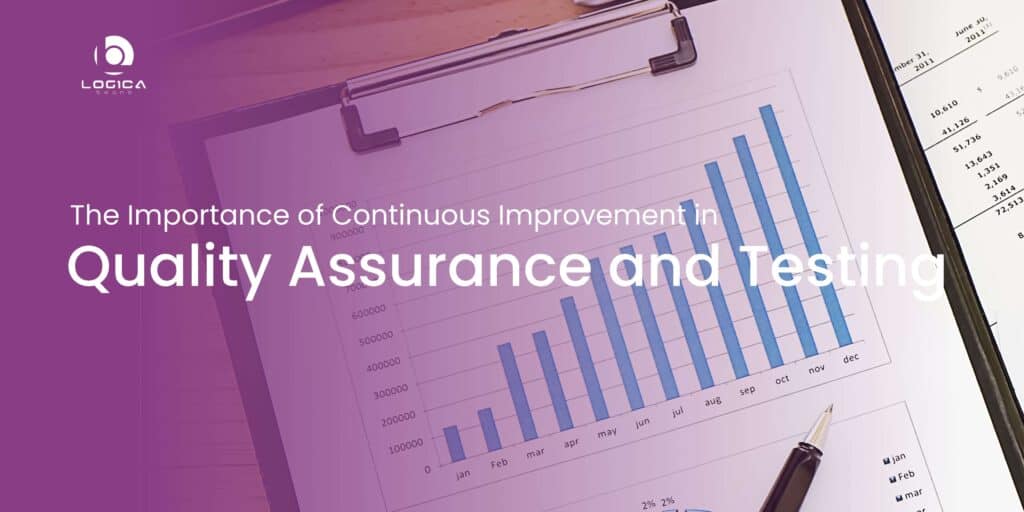In the world of software development, QA and testing are critical components that ensure the final product is functional, reliable, and meets the desired standards. However, with organizations under growing pressure to provide high-quality software fast, it is more crucial than ever to continuously enhance QA and testing. Continuous improvement helps firms to find areas for improvement in the software development process, make changes, and eventually offer better products to their consumers.
In this blog, we’ll discuss the significance of continuous improvement in QA and testing along with its advantages and best practices for incorporating it into your software development process.
Continuous improvement in QA and testing
Finding and applying changes to the software development process is part of the continual process of continuous improvement in QA and testing. Businesses engaged in software development must guarantee the quality of their finished products, cut expenses, and boost productivity.
Testing and quality control are crucial parts of software development. The process of finding and confirming that a software product or service satisfies the intended quality criteria is known as quality assurance. It seeks to avoid final product flaws or faults, boost effectiveness, and cut costs. Contrarily, testing is the process of assessing the quality of software by examining its usability, performance, dependability, and usefulness.
Businesses need to provide high-quality software quickly and effectively in order to stay ahead of their rivals in today’s highly competitive and competitive industry. This is where QA and testing need to continually improve. A methodical technique to raising the quality of goods, services, and operations is continuous improvement. Continuous improvement in the context of QA and testing entails routine evaluation and enhancement of the software development process, tools, and methodologies to guarantee that the end product’s quality is always increasing.
Continuous improvement in QA and testing offers various benefits. Businesses can lessen the likelihood of faults and flaws in the finished product by using it to detect and resolve issues early in the development phase. It results in increased productivity, reduced expenses, and higher levels of customer satisfaction. Continuous improvement also makes sure that the development process is always altering and adapting to the changing needs of the business, client feedback, and market expectations. In the long run, this can support profitable and competitive corporate operations.
Benefits of continuous improvement in QA and testing
Software development has grown to be an essential part of corporate operations in today’s fast-paced and dynamic technological environment. Nonetheless, it might be difficult to guarantee that software products are of a high caliber and satisfy consumer expectations. Testing and QA are used in this situation.
In order to guarantee that software products are dependable, effective, and satisfy user needs, QA and testing are crucial operations. Testing and QA, however, are dynamic procedures. Instead, they need constant modification to meet shifting client needs, technological improvements, and changing market trends.
Here are some of the top benefits of implementing continuous improvement in QA and testing:
● Early identification of errors and defects
Businesses can spot flaws and faults in the software development process early on thanks to continuous improvement. This aids in avoiding the inclusion of these problems in the finished work, which may be expensive and time-consuming to rectify later. Businesses may save time, money, and enhance the overall quality of their software by identifying and correcting issues early.
● Increased efficiency
Businesses may optimize their software development processes by using continuous improvement to get rid of extra procedures and bottlenecks. As a result, organizations are more effective and can produce high-quality software more quickly and consistently. Businesses may remain ahead of the competition by better adapting to changing market demands and company needs with an effective development process.
● Lower cost
Through the elimination of inefficient practices, the streamlining of procedures, and enhancements to general quality, continuous improvement may also assist organizations in lowering their expenses. Early problem detection and correction helps firms avoid expensive rework or delays. Additionally, firms may find chances for automation with the aid of continuous improvement, which eliminates the need for manual testing and other time-consuming chores.
● Improved customer satisfaction
Customer satisfaction might ultimately increase as a result of continuous development. Businesses may develop a devoted client base by providing high-quality software that meets or exceeds consumer expectations. Customers who are happy with the product or service are also more inclined to refer it to others, which generates new business and increases profits.
Best practices for implementing continuous improvement in QA and testing
A crucial component of software development that helps guarantee that software products are of high quality and satisfy customer expectations is continuous improvement in QA and testing. Yet, achieving continuous improvement in testing and quality control might be difficult. To make sure the procedure is successful and efficient, organizations need to implement best practices and cultivate a culture of continuous improvement.
Implementing continuous improvement in QA and testing requires a systematic approach. A systematic methodology is needed to implement continual improvement in QA and testing.
Here are some of the best practices for businesses to follow:
● Setting clear quality goals
Setting precise quality objectives is essential for carrying out a strategy of continuous improvement. Definitions of what quality means for the company and the program being produced are crucial. Goals for quality projects should be clear, quantifiable, doable, timely, and relevant (SMART). These objectives assist in concentrating efforts on enhancing the crucial elements of the software development process.
● Establishing a culture of continuous improvement
Implementing and maintaining a continuous improvement approach depend on cultivating a culture of improvement. Quality should be valued across the organization, and everyone should cooperate to achieve quality objectives. Management should support learning cultures, reward accomplishment, and foster innovation.
● Regularly assessing and analyzing the software development process
Finding areas that require improvement requires evaluating and analyzing the software development process. To pinpoint problems, monitor development, and assess success, it is crucial to adopt a data-driven strategy. Regular evaluations of the development process will assist pinpoint areas in need of improvement, and data analysis will help discover the problem’s underlying cause.
● Implementing changes and improvement
Implementing modifications and improvements is the last phase in a continuous improvement process. Changes should be made depending on the outcomes of the evaluation and analysis, and the process should be ongoing. Decide which modifications should be prioritized based on their potential influence on quality, then test the changes before making them. It’s crucial to keep an eye on how well the modifications are working and to adapt as necessary.
Tools and technique for continuous improvement in QA and testing
To facilitate continuous improvement in QA and testing, businesses can leverage a range of tools and techniques. Here are some of the most popular options:
● Tools for automated testing
Test automation software is becoming more and more common in software development. These tools are made to execute tests automatically, which can decrease the chance of human mistake and save time. Selenium, Appium, and TestComplete are a few well-known instances of automated testing technologies.
● Test driven development
Tests are written before code is written in a development approach called test-driven development, or TDD. This method lowers the chance of bugs and errors by identifying possible problems early in the development process. Agile methodologies frequently use TDD, which has been found to enhance productivity and improve code quality.
● Continuous integration and deployment
Software updates are automatically built, tested, and deployed using a set of procedures known as continuous integration and deployment (CI/CD). By automating the procedure, companies can lower the possibility of mistakes and guarantee that software updates are applied fast and consistently. Jenkins, Travis CI, and CircleCI are some common CI/CD tools.
● Metrics and data analysis
For identifying areas of the software development process that require improvement, metrics and data analysis are crucial. Businesses may see patterns, monitor their progress toward quality objectives, and make data-driven choices by evaluating their data. Defect density, defect detection rate, and test coverage are some of the frequently used metrics for QA and testing.
Continuous improvement model
To guarantee that goods and services are supplied with high quality and satisfy customer demands, the Continuous Improvement Model is frequently utilized in testing and QA process. The concept is sometimes referred to as the Quality Assurance Improvement Process (QAIP) or the Continuous Quality Improvement (CQI) model in this context (QAIP).
The Continuous Improvement Model generally involves the following four steps:
● Plan
The needs for testing and QA are determined in this stage, and a strategy is created to achieve them. This includes defining the scope of the testing, identifying the testing objectives and goals, and developing a test plan. Along with any necessary tools or resources, the plan should also outline the metrics that will be used to gauge how successful the testing process was.
● Do
The testing and QA processes are carried out in the second stage. This includes developing test cases, running tests, and analyzing the outcomes. Depending on the complexity of the product or service being evaluated, the tests may be automated or manual. Code reviews, design reviews, and other procedures to guarantee the caliber of the product or service may also be a part of the QA process.
● Check
The third phase is reviewing the outcomes of the testing and quality control procedures. This entails going over the test findings, finding any flaws, and assessing how well the testing procedure worked. Any required modifications to the testing procedure are performed after comparing the findings to the objectives and goals specified during the planning stage.
● Act
The final stage is to put the testing and QA activities’ findings into practice. This could entail making modifications to the tested good or service as well as resolving flaws and updating the test plan. The whole process, including the testing tools and methods employed, is improved using the lessons discovered during the testing and QA process.
Conclusion
Achieving and sustaining a high level of software quality requires constant development in testing and QA. You may find and fix problems early on, avoid software failures, and improve customer satisfaction by routinely analyzing and improving your QA methods and testing methodologies. Keep in mind that QA and testing are continual processes that call for an attitude of continuous improvement. This means that in order to provide better outcomes and surpass client expectations, you should always be searching for methods to improve your processes, test cases, and tools.










